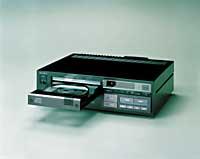Welcome, the highest CD
"It's compact, lightweight, works with a single button and is made from materials that almost never spoil." In this way the first sellers praised the CD. What they said was not entirely true, especially when it comes to deterioration, but at least there were big differences with the FCT. Very large. And looking back on history, it was a fundamental step for the sound industry.
The phonograph was invented by the American Thomas Edison. On December 4, 1887 he first heard his voice recorded on a cylinder. Thereafter there were many changes in sound recording technology. The cylinders were abandoned and the discs began to be used as support, the electrical system was improved and the amplifiers were incorporated, the LP discs were developed so that the engraving lasted a long time, reaching the stereo sound.

About 105 years after Edison's invention, the CD was released. The CD has recorded the digital sound code, which is, in short, the most suitable method to store a lot of information that currently exists and the possibility of making devices smaller and smaller.
Billy Joel
The first device to reproduce the CDs was launched by the company CBS/Sony, which developed the concept of disc together with two other companies, Philips and Polygram. This contributed greatly to the acceptance and dissemination of CD technology; the participation of more than one contributed to the rapid consolidation of system standards.
On October 1, 1982, Sony published the CDP-101 reader. The number 101 on behalf of this machine refers to the digital system, which in the binary system equals number five, and according to the author, was an accessible device for anyone who wanted to express with it.
The first reader paid 168,000 yen in Japan. It was a lot of money, but as always with technology, the CDP-101 reader quickly became cheaper.
In addition to the reader, CBS/Sony released fifty discs. The first was the 52nd street album by singer Billy Joel. By the end of the year there were a hundred records sold in Japan.
In addition to manufacturers, the market also quickly accepted the new standard. It is only twenty-two years since its release and has revolutionized the music industry. In the name of nostalgia efforts have been made for the FCT, but the CD has given space to the LP and cassette on almost all levels. Who does not currently have a CD player at home?
One material on another
Although it may seem otherwise, the compact disc is not a simple invention. The basic design consists of at least three materials, distributed in layers.
The goal of this organization is to store digital information, i.e. store numbers. These numbers are found in the binary system by a code composed of 0 and 1. Physically it is easy to express zeros and robes: in a material you only have to make holes.
Therefore, the reader must have a hole detection machine. It seems easy, right? As simple, but technologically complex, because the holes are 125 nanometers deep (and a nanometer is 1,000 million one meter). They are very small holes so they must be detected carefully through the laser.

The holes are "carved" into a layer of polycarbonate. Why polycarbonate? There are many reasons, but one of them must be highlighted: it is a transparent plastic material. Do not forget that the CD data is read optically through the laser, so they should use a material that does not generate any interference and opted for polycarbonate.
This is the main layer of the CD. There is the music (there are the numbers). The truth is that the music is also found in the aluminum layer that has above this polycarbonate, since this second layer is made on the perforated polycarbonate and where the hole is the aluminum layer is embossed.
Therefore, we have a plastic material and an aluminum in each layer. Aluminum acts as a mirror. It is a very appropriate metal, but like most metals, it must be protected from the atmosphere. That is why it has the top layer of other plastic material (for us the top of the disc, the part in which the letters are written). The latter is usually an acrylic polymer.
A really complex structure. Who would say that so many ingredients are needed to make a citrine CD?





